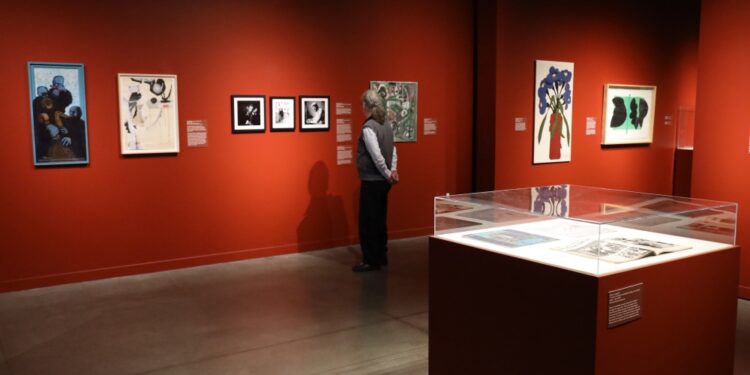“Southern Landscape” by Walter Williams is a renowned piece featured in the “Nordic Utopia?” exhibit at the National Nordic Museum. Williams, originally from New York, moved to Denmark to escape racial discrimination and became a Danish citizen in 1979. While his works predominantly reflect his life in Denmark, “Southern Landscape” retains nostalgic elements of his homeland. (Photo by Henry Behrens.) Img source: www.realchangenews.org
May 17, 2024 Story by: Editor
The 20th-century African American artists who sought refuge in the Nordic countries were driven not only by a desire to escape the brutal racial violence and systemic inequality in America but also by the rich cultural environment they found there.
“In the 1930s, musicians and singers toured the Nordic countries. Fats Waller remarked on their appreciation for swing music and their deep understanding of it, indicating there was an eager audience for performing artists,” explained Leslie Anne Anderson, Chief Curator of the National Nordic Museum in Seattle, in an interview with Forbes.com. “For visual artists like William H. Johnson, Paris was a starting point where he met his Danish artist wife before relocating to the Nordics.”
The National Nordic Museum’s exhibition, “Nordic Utopia? African Americans in the 20th Century,” delves into the compelling narratives of African American visual and performing artists who found creative sanctuary in the Nordic countries starting in the 1930s. This first-of-its-kind exhibit runs through July 21, 2024.
Anderson’s inspiration partly came from William H. Johnson (1901-1970). Her interest was reignited when Ethelene Whitmire, Chair and a professor in the Department of African American Studies at the University of Wisconsin–Madison, presented at the National Nordic Museum in 2019. Both Anderson and Whitmire, past American-Scandinavian Foundation Fellows and Fulbright Fellows, shared common ground, including time spent at the University of Copenhagen.
Whitmire’s lecture focused on African Americans in Denmark. Following her talk, Anderson and Whitmire discussed a potential collaboration, initially considering a focus on Johnson. Johnson was gaining recognition, highlighted by a solo exhibition at the Smithsonian American Art Museum and a feature in the Metropolitan Museum of Art’s “The Harlem Renaissance and Transatlantic Modernism.” Despite the pandemic delaying their plans, Anderson and Whitmire reconnected in 2021 to propose a broader, pan-Nordic exhibition covering a wider array of Black artists across various creative disciplines.
From the soulful melodies of jazz legend Dexter Gordon (1923-1990) to the bold expressions of multimedia artist Howard Smith (1928-2021), and the captivating movements of choreographer Doug Crutchfield (1938-1989), “Nordic Utopia?” showcases how these trailblazing figures found an environment in the Nordic region that was uniquely conducive to innovation and artistic exploration.
Their journeys primarily took them to the Nordic capitals: Copenhagen in Denmark, Helsinki in Finland, Stockholm in Sweden, and Oslo in Norway.
“They discovered a place where they could unleash their creativity and pursue opportunities that were often unavailable to them in the United States,” Anderson noted. “We were intentional with the question mark in the title because while a true utopia doesn’t exist, these artists largely reported that their professional and personal experiences were significantly better in the Nordic countries.” Source: Forbes
During the peak of the Jim Crow era in the 1930s, long before the Civil Rights Act of 1964 aimed to establish racial equality in public life and employment—a goal still not fully realized in America—African Americans faced severe physical violence, state-sponsored discrimination, and racial prejudice that stifled their creative energy and joy.
World War II temporarily halted the initial wave of African American artists traveling to the Nordic countries, but the journeys resumed thereafter.
Visiting ‘Nordic Utopia?’
“Nordic Utopia?” offers an extensive exploration of how African American artists found creative freedom in these predominantly white countries through artifacts, music, paintings, drawings, sculpture, ceramics, textiles, photography, film, and journalistic writings.
Highlights include works by William H. Johnson from the Smithsonian American Art Museum and the National Gallery in Washington, DC. Additionally, personal collections of artists like Ronald Burns and Howard Smith, generously shared by their families, provide intimate glimpses into their lives and works.
After its display in Seattle, the exhibition will travel to the Chazen Museum of Art in Madison, WI, and Scandinavia House in New York City.

















